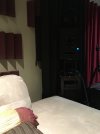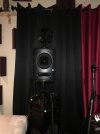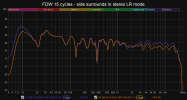Maybe. Once I finish acoustically treating my room, if my speakers aren’t transparent enough, and after I get new speakers, since mine are 30 years old and I didn’t not even know what they are with any detail. But honestly, this seems like throwing more gadgets and money into the chain for what is likely pretty marginal improvement, objectively.
In my case, it would likely at a minimum mean switching computer platforms (along with the knock-on effects). Adding yet another device in the audio chain, and likely, to make it worthwhile, getting new speakers and an amp to run every driver independently.
So I’ll treat acoustics, maybe measure my drivers, and listen to music seemingly coming out of the air in front of me even though the signals can’t possibly be time-aligned to such a degree and the sound waves are arriving out of phase, logically.
I understand your stance quite well since my "policy and strategy" in multichannel multi-amplifier project are/were almost similar to yours. The "perfect time alignment" should be tried at the final stage of your project, just like I did it in my project.
Just for your reference, you may find my "pre-project history and background" in these posts;
#030,
#128,
#178,
#015(remote thread).
Furthermore, my main SPs are also rather old ones, about 40 years old YAMAHA NS-1000 and drivers. I know the midrange Be-squawkers and high-range Be-tweeters are still having world top-class specs and performances.
As for the "aged" woofer, YAMAHA 30 cm cone JA-3058, however, I have been a little bit worried about the possible tired performances at present, and this worry encouraged me to fully measure the transient characteristics of my JA-3058 as shared in my post
#495 and
#497. As the results, I was again really impressed by the still-really-amazing transient characteristics/performances of this old 30 cm woofer.
It took almost three years until I could fully establish multichannel multi-way multi-driver multi-amplifier stereo audio setup with NS-1000's woofers, Be-squawkers, Be-tweeters, plus sub-woofers YST-SW1000 and super-tweeters FOSTEX T924A. (You may find the hyperlink index for my project thread
here and
here.)
Until very recently, until the end of last year 2021, I was really satisfied with the total sound quality, including fairly nice disappearance of SPs, with my almost completed multichannel multi-amplifier setup and configuration, with no group delay (no time alignment) control. Only last month, in January this year, I carefully considered and planned trying the time alignment measurements and controls using my own primitive but reliable method "with little expectation" for further improvement in total sound quality.
As shared in
my post #520 on the project thread, I am now very happy in sharing that "Perfect (0.1 msec precision) time alignment of all the SP drivers greatly contributes to
further amazing disappearance of SPs, tightness and cleanliness of the sound, and superior 3D sound stage."
In any way, I do hope much good luck in your multichannel multi-amplifier setup, and you would please try "perfect time alignment" all over of your SP drivers in the final stage of your project.



